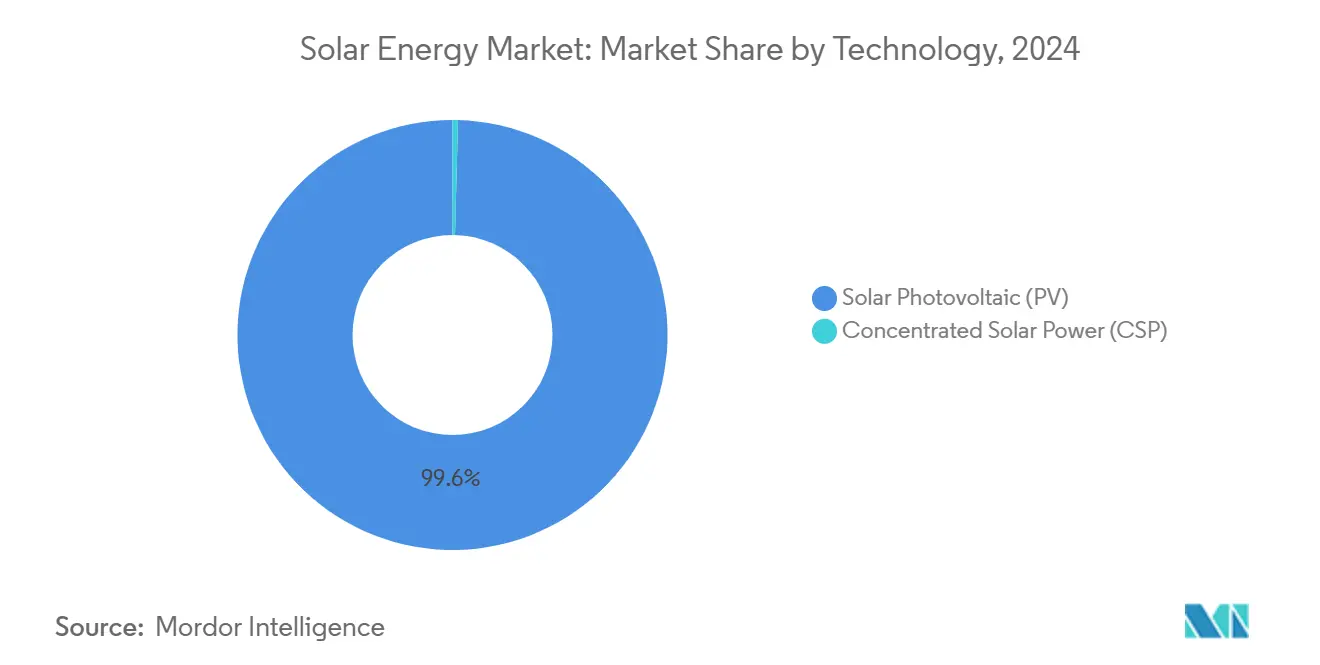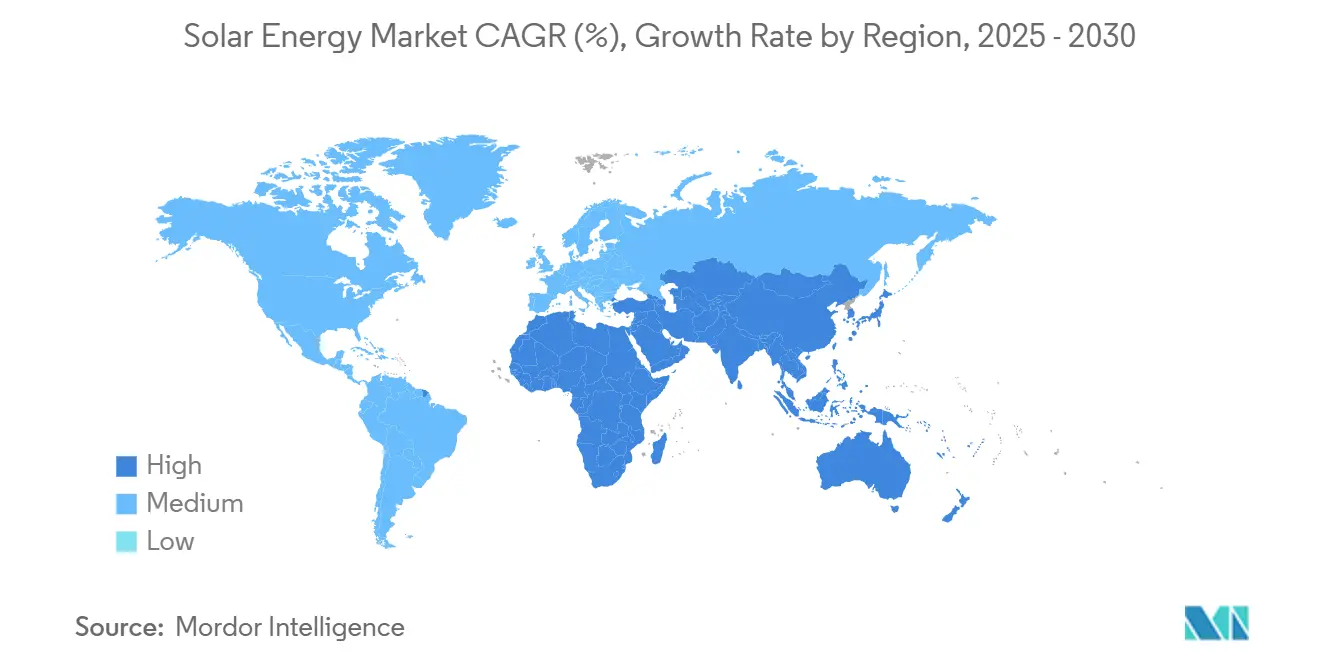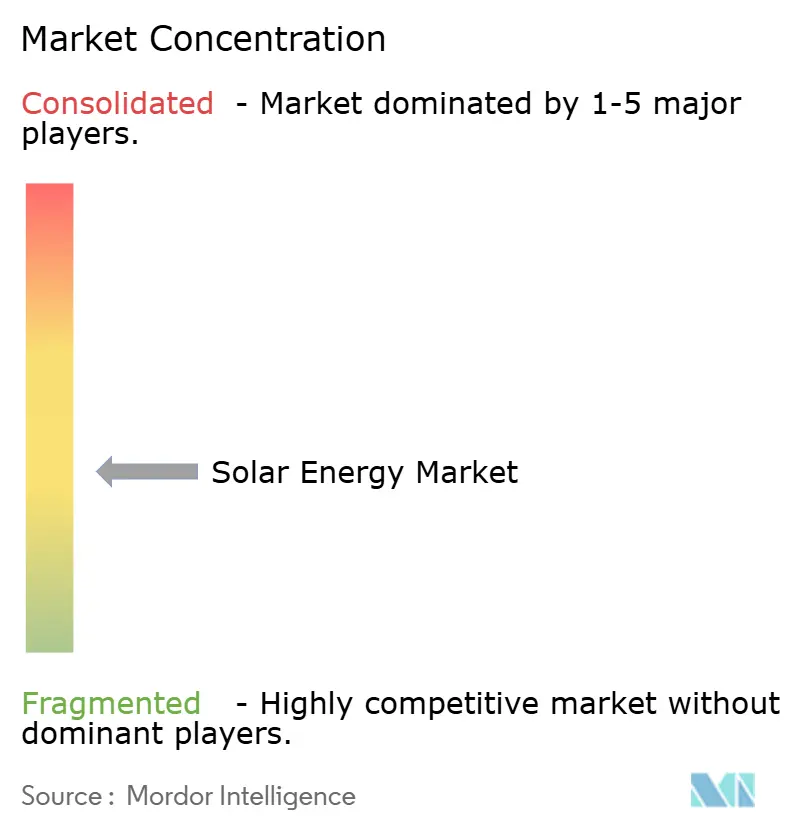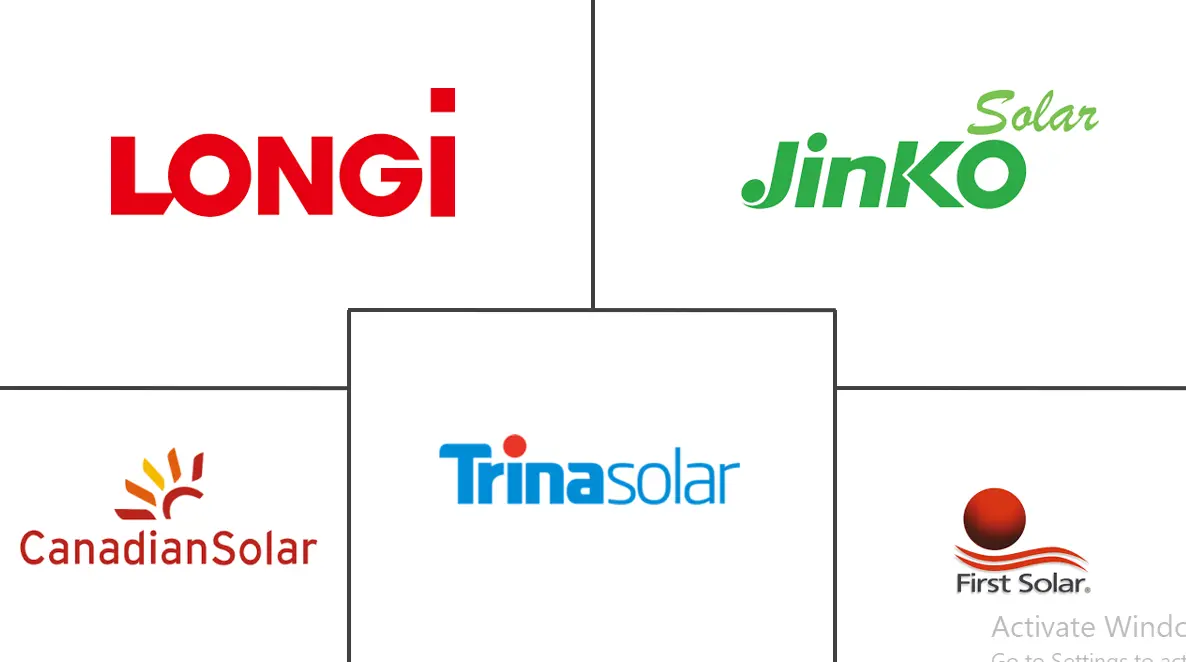
Solar Energy Market Analysis by Mordor Intelligence
The Solar Energy Market size in terms of installed base is expected to grow from 2.35 Thousand gigawatt in 2025 to 6.26 Thousand gigawatt by 2030, at a CAGR of 21.64% during the forecast period (2025-2030).
This rapid expansion shows that the solar energy market has crossed the subsidy-dependence phase and is now price-competitive with conventional power in most major economies. Module prices continue to fall, energy-storage pairings are converting variable output into dispatchable power, and supportive policy frameworks, such as the Inflation Reduction Act in the United States and record-low auction tariffs in the Middle East, have anchored investor confidence. New demand is coming from data-center operators, electric-vehicle charging networks, and green-hydrogen projects, broadening the customer base well beyond traditional utility procurement. In parallel, bifacial modules, tracker systems, and artificial-intelligence (AI) software for plant optimization are pushing project yields higher, reinforcing a virtuous cycle of cost reduction and scale.
Key Report Takeaways
- By technology, solar photovoltaic commanded 99.6% of the solar energy market share in 2024; concentrated solar power lags with 0.4% but still offers niche benefits such as long-duration thermal storage.
- By grid type, on-grid systems accounted for 89.56% of deployments in 2024, whereas off-grid solutions are expected to advance at a 24.12% CAGR to 2030.
- By end-user, utility-scale installations represented 52.11% of the 2024 solar energy market size; the residential segment is forecast to grow at a 23.23% CAGR through 2030.
- By geography, Asia-Pacific led with 64.11% of 2024 capacity; the Middle East and Africa region is projected to expand at a 24.36% CAGR over 2025-2030.
Global Solar Energy Market Trends and Insights
Drivers Impact Analysis
| Driver | (~) % Impact on CAGR Forecast | Geographic Relevance | Impact Timeline |
|---|---|---|---|
| Utility-scale PV cost parity | +4.2% | Asia-Pacific, spillover to Middle East & Africa | Medium term (2-4 years) |
| IRA-supported U.S. manufacturing expansion | +3.1% | North America | Medium term (2-4 years) |
| Corporate PPA uptake by AI & data centers | +3.8% | North America, Europe | Short term (≤2 years) |
| Hybrid PV-battery revenue stacking | +3.5% | Global, early uptake in Europe & North America | Medium term (2-4 years) |
| Floating and agrivoltaic deployment | +2.6% | Asia-Pacific, Europe | Long term (≥4 years) |
| Green-hydrogen mega-projects | +2.9% | Middle East & Africa | Long term (≥4 years) |
| Source: Mordor Intelligence | |||
Utility-Scale PV Cost Parity Accelerating Procurement in Asia
Grid-parity tariffs as low as USD 0.0135/kWh in 2024 auctions have positioned utility-scale solar as the default option for new capacity additions across Asia. China added 277.57 GW in 2024, lifting cumulative PV to 885.68 GW.[1]International Energy Agency, “Solar PV Tracker,” iea.org State-owned utilities view solar as a hedge against imported-fuel volatility and as a compliance tool for tightening carbon-intensity mandates. Cost parity is also cascading into markets such as India, which now sources 22% of its power from renewables and is scaling tender volumes accordingly. These dynamics underpin the Asia-Pacific share leadership in the solar energy market and validate long-run demand projections.
IRA-Driven Domestic Manufacturing Boom in the United States
The Inflation Reduction Act triggered a 190% rise in U.S. module-assembly capacity, topping 50 GW by early 2025, with new polysilicon and wafer projects announced for delivery before 2027. [2]Solar Energy Industries Association, “U.S. Solar Market Insight 2025,” seia.org Shorter supply chains lower logistics risk and broaden the local job base, yet Chinese firms still supply almost half of announced capacity, highlighting ongoing policy tension around energy independence. The domestic build-out enlarges the solar energy market while gradually diversifying upstream concentration.
Corporate PPA Demand from AI & Data Centers in Europe & North America
Projected data-center electricity demand could reach 12% of U.S. load by 2028, compelling hyperscalers to lock in renewable supplies. Meta’s 650 MW solar offtake in 2025 exemplifies 24/7 clean-power contracting that values hourly matching and grid-support services. Spain tops European PPA capacity, illustrating how credible regulatory frameworks accelerate corporate sourcing. These contracts enlarge the bankable pipeline for the solar energy market in both regions.
Hybrid PV-Battery Projects Unlocking New Revenue Stacking Models
California ISO battery capacity climbed from 500 MW in 2020 to 11,200 MW by mid-2024, more than half co-located with renewables. Simulations show revenue increases of 75% when assets tap multiple markets, day-ahead, frequency response, and capacity services, versus single-market operation. As hardware costs fall and trading algorithms improve, hybridization raises the effective solar energy market size by capturing value otherwise lost to curtailment.
Restraints Impact Analysis
| Restraint | (~) % Impact on CAGR Forecast | Geographic Relevance | Impact Timeline |
|---|---|---|---|
| Over-reliance on Chinese polysilicon & wafers | -2.3% | Global; highest in North America & Europe | Medium term (2-4 years) |
| Grid congestion & curtailment | -1.9% | China, Europe, emerging in North America | Short term (≤2 years) |
| Rising interest rates affecting residential solar | -1.6% | North America, Europe | Short term (≤2 years) |
| Rare-earth scarcity for high-efficiency thin films | -1.2% | Global | Long term (≥4 years) |
| Source: Mordor Intelligence | |||
Supply-Chain Over-reliance on Chinese Polysilicon & Wafers
China is heading for 95% of global polysilicon, ingot, and wafer output by 2025, reinforcing a fragile concentration. U.S. tariffs on imported wafers jump to 50% in 2025, yet Chinese spot polysilicon prices slid to USD 4.70/kg versus an estimated sustainable USD 21/kg, underscoring subsidy-fuelled cost gaps. Such asymmetry deters alternative supply lines and exposes downstream players to geopolitical events, weighing on long-term planning for the solar energy market.
Grid Congestion & Curtailment in High-Penetration Provinces
Curtailment reached 28% during low-demand periods in Cyprus and 12 TWh across Europe in 2023. California’s marginal curtailment rate for new solar projects is 9%, twice the statewide average. Lost output erodes project returns and raises financing costs. Grid-enhancement tools, dynamic line rating, advanced forecasting, and storage, are essential to limit this drag on the solar energy industry.
Segment Analysis
By Technology: PV Dominance Drives Innovation
Solar photovoltaic held 99.6% of 2024 capacity, confirming its status as the cornerstone of the solar energy market. Falling levelized costs, down 4.6% in 2024, place PV ahead of gas peakers and onshore wind in many regions. The segment is expected to grow at 22.12% CAGR through 2030, powered by efficiency gains such as perovskite-silicon tandem cells hitting 31.6% laboratory performance. Multi-junction designs could push conversion rates beyond 40%, opening space-constrained rooftops and vehicle-integrated niches.
CSP’s 0.4% slice persists where thermal-storage duration outweighs battery economics. Particle-based receivers can raise annual energy by 7.4% and lower LCOE to USD 192/MWh versus molten-salt baselines of USD 211/MWh. While this narrows the gap, PV paired with four-hour batteries costs less in most markets, limiting CSP uptake. The solar energy market nonetheless benefits from CSP’s R&D spill-overs in high-temperature materials and heliostat controls.

Note: Segment shares of all individual segments available upon report purchase
By Grid Type: Off-Grid Solutions Address Energy-Access Challenges
On-grid systems delivered 89.56% of 2024 installations, making the interconnected network the largest outlet for the solar energy market. Net-metering rules and wholesale power exchanges allow prosumers to monetize surplus generation. However, the off-grid segment, valued at USD 2.40 billion in 2024, is forecast to advance at a 24.12% CAGR, reaching USD 6.39 billion by 2031. Uptake is strongest in sub-Saharan Africa and island economies where grid extension costs exceed USD 2,000/km.
Cash-free “pay-as-you-go” financing and falling battery prices accelerate rural electrification. The off-grid solar energy market size for Africa alone could exceed 30 million connections by 2030, according to regional development-bank scenarios. Product innovation, such as integrated DC appliances and modular battery swaps, continues to lower the total cost of ownership and spur adoption among last-mile users.
By End-User: Residential Segment Accelerates Despite Challenges
Utility-scale projects held 52.11% of 2024 deployments thanks to economies of scale, evidenced by the United States adding 41.4 GW of large-scale capacity that year. Developers leverage land-lease pricing, bulk procurement, and improved tracker designs to undercut wholesale price benchmarks. Yet the residential segment is poised for the fastest growth at 23.23% CAGR from 2025-2030, even after a 32% volume dip in 2024 amid elevated interest rates. Lower financing costs projected from mid-2025 and rising electricity tariffs are expected to restore household paybacks.
Community solar bridges residential carbon goals and utility economics, hitting a record 1,745 MWdc in 2024, driven by New York policies. Commercial and industrial rooftops grew 8% in 2024, supported by corporate decarbonization commitments and demand from AI data centers. Battery attach rates reached 35% of new residential installs, up from 21% in 2022, illustrating how storage is redefining value in the solar energy market.

Note: Segment shares of all individual segments available upon report purchase
Geography Analysis
Asia-Pacific retained a 64.11% capacity share in 2024, underpinned by China’s 277.57 GW annual addition and a cumulative 885.68 GW fleet. Gigafactories across Jiangsu and Anhui provinces supply more than 80% of global wafers, reinforcing the region’s upstream dominance. India secured third place worldwide with 30.7 GW of new capacity in 2024, a 145% jump, as tender pipelines align with its 2070 carbon-neutrality pledge.[3]SolarPower Europe, “Global Market Outlook 2025,” solarpowereurope.org Japan, South Korea, and Taiwan are piloting floating and agrivoltaic models to bypass land constraints, while Australia’s rooftop penetration tops 37% of free-standing dwellings, demonstrating the breadth of strategies inside the region’s portion of the solar energy market.
The Middle East & Africa is the fastest-growing territory, expected to clock a 24.36% CAGR through 2030. Regional renewables capacity reached 30.3 GW by end-2024, more than doubling since 2020, with the UAE at 6.3 GW, Egypt at 4.6 GW, and Saudi Arabia at 4.5 GW. Competitive auction bids under USD 0.013/kWh spur mega-scale solar, and national hydrogen roadmaps target 236 GW of combined renewable capacity by 2030. These ambitions reshape trade flows as Gulf exporters plan ammonia corridors to Europe and Asia.
North America and Europe remain critical to global demand. The United States installed nearly 50 GWdc in 2024, making up 66% of new utility generation that year. Domestic manufacturing incentives and AI-driven corporate PPAs underpin the growth outlook, but grid congestion around key hubs such as PJM and CAISO poses near-term challenges. Europe built 65 GWdc in 2024 and is forecast to exceed 70 GWdc in 2025 despite rising curtailment in Spain and Germany. Enhanced interconnectors, grid-scale batteries, and market-design reforms are therefore high on the policy agenda to protect the region’s share of the solar energy market.

Competitive Landscape
The global solar energy market shows moderate concentration. Nine Chinese firms shipped more than 232 GW of modules in 1H 2024, led by JinkoSolar (47.2 GWp), JA Solar (38 GWp), Trina (34 GWp), and LONGi (31.3 GWp). Scale and tight vertical integration provide margin advantages, while R&D budgets channel into n-type TOPCon and heterojunction cells to lift efficiency above 25%. First Solar differentiates with cadmium-telluride thin films, producing 15.5 GW in 2024 and targeting 25 GW by 2026.[4]Freedom24, “First Solar Investor Briefing,” freedom24.com
Inverters constitute an arena where non-Chinese competitors still hold ground: Sungrow, Huawei, SMA, and SolarEdge compete on software features, cybersecurity, and grid-support functions as string architectures replace central inverter blocks in both utility and C&I projects. AI-powered predictive maintenance platforms, often bundled with inverter SCADA, are emerging as key procurement criteria.
M&A activity is widening the field. HVAC majors and rooftop-equipment firms are entering solar through bolt-on deals that combine roofing, batteries, and panels into single-vendor propositions. Residential installer Zeo’s 2025 acquisition of thermal-storage specialist Heliogen illustrates the push toward integrated offerings. Meanwhile, Qualitas Energy’s subsidiary Heelstone expanded its U.S. development pipeline beyond 5 GW after acquiring Valor Infrastructure assets. The race now centers on who can pair hardware, software, and financing into the most compelling customer package across each node of the solar energy market.
Solar Energy Industry Leaders
LONGi Green Energy Technology
JinkoSolar Holding
Trina Solar
Canadian Solar
First Solar
- *Disclaimer: Major Players sorted in no particular order

Recent Industry Developments
- May 2025: Meta signed two PPAs with AES for 650 MW of solar to run data centers in Texas and Kansas, adding to Meta’s 12 GW renewable portfolio.
- May 2025: Heelstone Renewable Energy bought Valor Infrastructure’s 190 MWp PV pipeline in Texas, lifting its U.S. platform above 5 GW.
- May 2025: Zeo acquired Heliogen to integrate thermal storage into its residential solar offer.
- May 2025: Summit Ridge Energy purchased a 40 MW Illinois community-solar bundle from Arena Renewables, enough to power 5,000 homes.
Research Methodology Framework and Report Scope
Market Definitions and Key Coverage
Our study defines the global solar energy market as all grid-tied and certified off-grid photovoltaic (PV) and concentrated solar power (CSP) plants whose cumulative installed capacity is operational worldwide. Capacity is measured in gigawatts and reflects the asset base, not module sales or electricity revenues.
Scope exclusion: Solar thermal water heaters and manufacturing equipment are excluded.
Segmentation Overview
- By Technology
- Solar Photovoltaic (PV)
- Concentrated Solar Power (CSP)
- By Grid Type
- On-Grid
- Off-Grid
- By End-User
- Utility-Scale
- Commercial and Industrial (C&I)
- Residential
- By Component (Qualitative Analysis)
- Solar Modules/Panels
- Inverters (String, Central, Micro)
- Mounting and Tracking Systems
- Balance-of-System and Electricals
- Energy Storage and Hybrid Integration
- By Geography
- North America
- United States
- Canada
- Mexico
- Europe
- United Kingdom
- Germany
- France
- Spain
- Nordic Countries
- Russia
- Rest of Europe
- Asia-Pacific
- China
- India
- Japan
- South Korea
- Malaysia
- Thailand
- Indonesia
- Vietnam
- Australia
- Rest of Asia-Pacific
- South America
- Brazil
- Argentina
- Colombia
- Rest of South America
- Middle East and Africa
- Saudi Arabia
- United Arab Emirates
- South Africa
- Egypt
- Rest of Middle East and Africa
- North America
Detailed Research Methodology and Data Validation
Primary Research
Mordor analysts interviewed independent power producers, EPC firms, grid planners, and regulators in Asia-Pacific, North America, Europe, and MENA. Their insights confirmed commissioning dates, curtailment risks, and module ASP movement, letting us align model assumptions with field reality.
Desk Research
We opened with free, authoritative datasets such as IEA PV statistics, SolarPower Europe outlooks, IRENA inventories, customs shipment logs, and national energy ministry bulletins. Paid repositories, D&B Hoovers for financials, Dow Jones Factiva for project news, and Questel for patent alerts, back-checked corporate footprints and technology flows. A second sweep captured auction results, battery attachment rates, and IRA tax filings that reveal real build schedules and price curves. Many additional open records were reviewed to corroborate figures.
Market-Sizing & Forecasting
We start top-down from 2024 cumulative capacity, layer projected annual builds drawn from policy targets, auction pipelines, and historic utilization, then run selective bottom-up checks (supplier roll-ups and sampled ASP × MW). Key variables include module price decline, grid-connection queue length, battery coupling share, carbon-price trends, and utility-scale share. A multivariate regression extends these drivers to 2030, while scenario analysis tests upside from green-hydrogen demand. Local data gaps are bridged with regional intensity factors.
Data Validation & Update Cycle
Outputs pass peer review; variance flags trigger re-runs against independent tallies. Reports refresh every twelve months, with interim updates after material policy or price shifts, and a final analyst sweep before release.
Why Mordor's Solar Energy Baseline Earns Decision-Makers' Trust
Published estimates differ because firms track dissimilar metrics, vintage years, and price paths. Our capacity-based lens, refreshed with real-time policy and auction data, provides a consistently up-to-date view.
Key gap drivers include revenue-only scopes, older baselines, and untested ASP trajectories.
Benchmark comparison
| Market Size | Anonymized source | Primary gap driver |
|---|---|---|
| 2.35 thousand GW (2025) | Mordor Intelligence | |
| USD 368.66 billion (2025) | Global Consultancy A | value scope, PV-only, conservative build rate |
| USD 273.00 billion (2024) | Trade Journal B | mixes equipment sales and generation income, older baseline |
As the table shows, by centering on clearly defined capacity and continuously refreshed drivers, Mordor Intelligence offers a transparent, reproducible baseline decision-makers can rely on.
Key Questions Answered in the Report
What is the projected capacity of the solar energy market by 2030?
Installed capacity is expected to reach 6,259.75 GW by 2030, growing at a 21.64% CAGR.
Which region leads the solar energy market today?
Asia-Pacific holds 64.11% of global capacity, powered by China’s manufacturing scale and deployment targets.
Why are hybrid PV-battery projects gaining momentum?
Pairing storage with solar raises revenue by letting assets tap energy, reserve and capacity markets, improving project economics.
Why are hybrid PV-battery projects gaining momentum?
Pairing storage with solar raises revenue by letting assets tap energy, reserve and capacity markets, improving project economics.
How is AI influencing solar demand?
Data-center operators sign large renewable PPAs to meet rising electricity needs, adding multi-gigawatt demand for new solar plants.
What challenges could slow solar deployment?
Supply-chain concentration in China and grid curtailment in high-penetration regions could trim the growth rate unless mitigated.
Which segment is forecast to grow fastest through 2030?
Residential installations, driven by falling battery costs and supportive financing models, are set to expand at a 23.23% CAGR.



